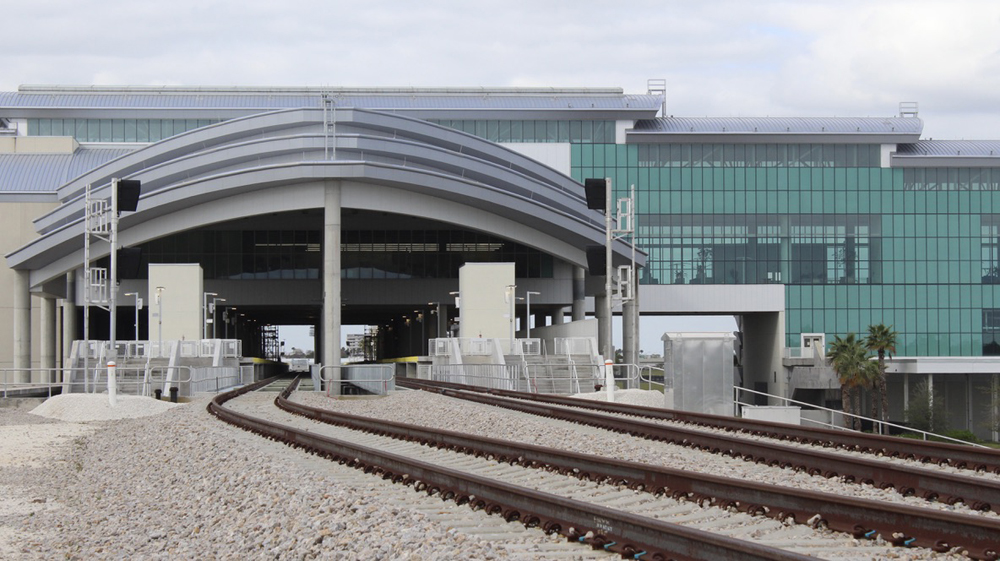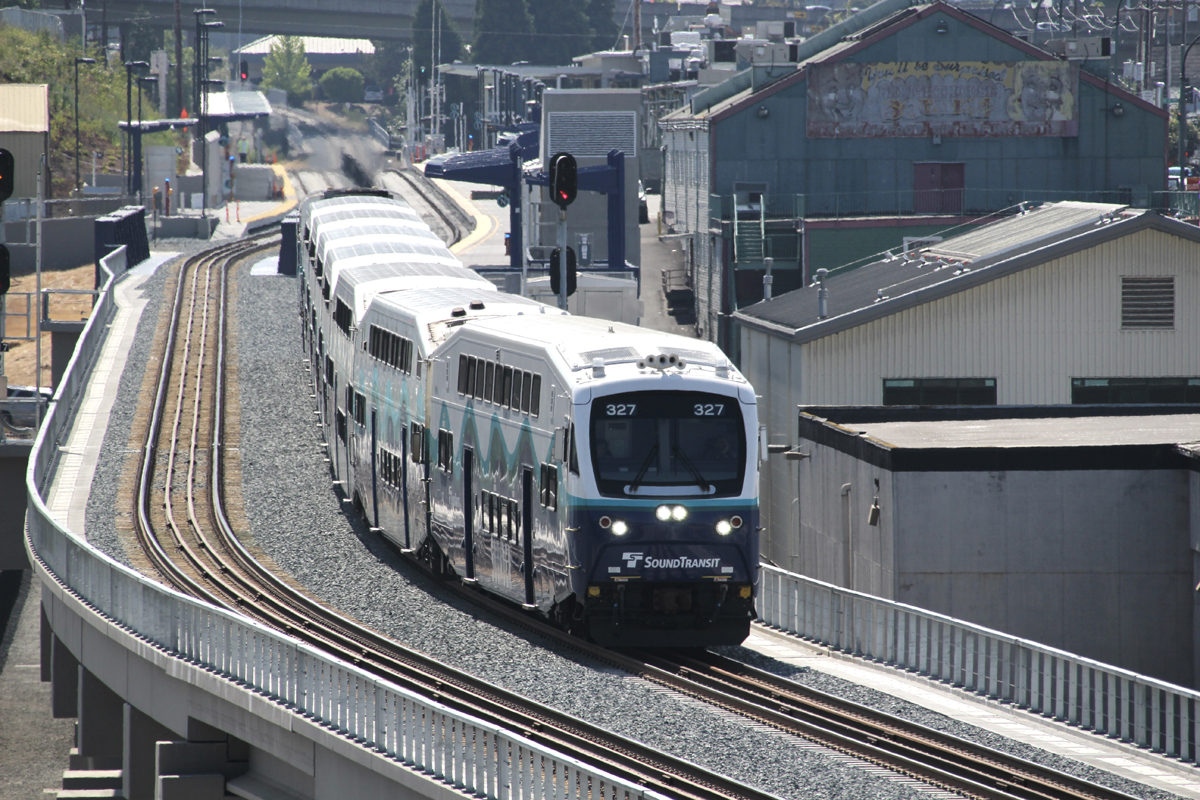
ORLANDO — A new Florida Department of Transportation document details how a passenger and commuter rail extension west from Brightline’s Orlando International Airport station could be funded and built with the help of federal infrastructure money — and that the project could cost $6 billion.
The “Sunshine Corridor” concept, announced in May, calls for public funds to help build a new right-of-way for Brightline, as well as commuter service SunRail, to reach the Orange County Convention Center and nearby attractions [see “Orlando businesses pledge $125 million …,” Trains News Wire, May 6, 2022]. The partnership may have helped the state win a federal Consolidated Rail Infrastructure and Safety Improvement grant for Brightline’s Tampa extension a month later [see “Florida receives $15.875 million engineering grant …,” News Wire, June 2, 2022].
A paywalled Orlando Sentinel report provides details on the DOT “white paper“ document, not yet available publicly, and other aspects of the project, including the price tag.
After winning the CRISI funds, Florida Department of Transportation officials, politicians representing the area in Congress, and the mayors of Orlando and Orange County decided to make sure U.S. Department of Transportation judges could see how all the pieces would fit together.
U.S. Rep. Darren Soto (D-Fla.) expects 10 years of funding prescribed in the infrastructure law to include 50% from the federal government and a 50% match — likely to be half from the state and half from Brightline and its local partners. It would be made available through multiple grants, not “one big announcement — like here is $3 billion,“ he told the Sentinel.
SunRail’s involvement means various aspects of the project could qualify for grants from both the Federal Railroad Administration and Federal Transit Administration.
The willingness of Brightline and major attractions to contribute to the 50% match is a significant competitive selling point, but the mayors of Orlando and Orange County believe a one-cent increase in the area sales tax is necessary to ensure SunRail and expansion of the Lynx bus system remain viable. A referendum asking voters to approve that increase will be on the November ballot. Orange County Mayor Jerry Demings told the Sentinel that the time frame for expanding Lynx was one to five years, while completing all aspects of the rail component would be on an eight- to-10-year timeline.
The rail project will be developed in three phases:
— From the airport to a connection with SunRail’s north-south corridor (also used by Amtrak trains);
— From that connection to the Convention Center and International Drive attractions area;
— On to Tampa, principally down the median of Interstate 4.














I could easily be off base but my two cents is Brightline by separating themselves from Disney and instead going along with a business group/other theme parks to team up with Sunrail and now appears Amtrak opens up some funding avenues that go beyond the real estate. The model could get brightline to Tampa a lot quicker then most people think as well as a model that they might be pursuing on their LA to Las Vegas.. Can see Brightline indirectly benefiting from two rail infrastructure grants that help them get to Tampa on west coast as well as Las Vegas on the other coast.
At same time it gives Feds an opportunity to promote private rail development. I rather see that happen then say some of the Amtrak Connect plans being pushed by states. A private passenger rail pushing and securing private capital to build out passenger rail between big metro areas, whether it be Miami/Orlando/Tampa and or LA/Las Vegas.
The other reality is that the distance between Orlando and Tampa not far so doubt that Brightline really wants or desires more stations impacting travel times (loosing out on car competitiveness) and therefore limiting real estate development. However, no reason a corridor planned right, signaled right cant support Sunrail/Commuter on one end, Amtrak (70 mph) and Brightline express (110 mph). But I believe that corridor will need to be double track, maybe some triple track for stations and therefore the added cost (infrastructure funds). Someone with real knowledge can chime in on what would really be needed to support all the above – Brightline, Amtrak & Sunrail on Orlando side
The Sunshine Corridor is showing what happens when private money interests and their politician friends muck up a simple concepts. Instead of Sunrail serving the airport now via the A Line-Brightline connection or Brightline using the FL 417 expressway to I-4 Tampa these interests and their politician friends favor an unreasonably costly route. This new routing requires numerous bridges and costly right of way purchases with the expected infrastructure costs. If you look at the new route it is a convoluted heading north before heading south on I-4. At least start having Sunrail got to the airport from the A-Line. It would cost little as the tracks and connections are already in place.
Translation: This ain’t happening.
SunRail to be viaable must reach OIA (MC0).
You are correct Mr. Markfelder. Whether private investment or public/private investment transit & passenger rail will always face an uphill battle against the powerful Hwy, oil & auto industry special interest groups who have unlimited funds (i.e.) political influence to direct American’s transportation options.
Please consider a line connecting northbound to Jacksonville and even to Atlanta!!!
There is plenty of “want” in greater Jacksonville for high speed connectivity with the rest of Florida, and they have been pretty clear about that in the press. But Brightline deferred on any thoughts of Jacksonville as any kind of endpoint because the public transit options in the area are really bad.
Bad in that the services offered aren’t cohesive. They are just starting to use TOD (transit oriented development) in their zoning. They just got their 3 spoke BRT system in place. But havent’ figured out what to do with their federally funded people mover downtown. And many of these are connected by a bus system that is not highly regarded by the locals.
If Brightline were to work in Jacksonville, they would be highly dependent on mobility via transit to reach a future Brightline station.
At the moment the Jacksonville area is looking at a heavy rail scheme from Yulee, through downtown and on to St Augustine. St Augustine is now in the Top 10 of several global traveler guides and they are arriving via the airport at JIA and renting cars for the 45 mile drive down.
I just wouldn’t expect any Brightline extensions to Jacksonville in any near future even though all the legal entities to support a future service is already in place.
Florida is in need of improved and expanded rail and bus service but the timeline for this to happen is too long with many obstacles and political changes that can and will occur to slow this expansion plan down with changes and a watered down version of this plan. Also don’t forget that Florida is one of those states that is car-centric and the majority of Floridians having a love affair with their cars. Even now Florida plans more highway expansion and doubledecking a few exisiting highways to accomodate the ever increasing load of cars along with new residents moving to Florida. The Brighline/Sunrail plan is a positive step in the right direction but faces an uphill battle in a carcentric state
Joseph C. Markfelder
DeSantis will go full-metal (Scott) Walker on this, and never allow it. You think he’s going to do anything that Disney wants or agrees with?
I think you misrepresent Mr DeSantis perspective. Disney has already rejected the concept of a Brightline station on Disney property. But that does not preclude a station off Disney property in Kissimmee. There is already vacant land across I-4 opposite Disney Springs that was in the original concept for Tampa service. So at this point Disney has little or not much to add to the conversation. They will do what they have done thus far, put a blue bus service from the new station to their property. Disney could have expanded their monorail right into a new station if they so chose, but won’t. They want parking revenue and the monorails are expenses they would rather do without and don’t want to grow. (I think Walt would be more creative to be honest).
But the point made by Mr. Bourgeois is spot on. Brightline relies heavily on real estate and infrastructure revenue along the right of ways to support their business model. Look for a Miami Central like development in downtown Tampa where Flagler Development is the core owner/operator.
But I-4 as a ROW does present some funding challenges. It does not (by design) pass through any city centers like the FEC does. This limits the types of real estate Brightline can put down and collect revenue from.
No doubt why they are looking for a combination of grants, theme park money, Brightline money, transit funds and other revenue sources.
It there is a connection to the corridor Amtrak is using, it won’t be surprising if they eventually want to use the Brightline corridor to Tampa.
The Brightline model has a real estate investment component to its original Miami-Cocoa Beach segment. It will be interesting to see how that fares long-term with having to cover 100% of the right of way maintenance costs out of ticket sales for the Cocoa Beach-Orlando-Tampa segment. There is a lot of borrowed funds so far with debt payments that must be serviced. Hopefully the revenue streams will be there. Time will tell.
What is old is new!